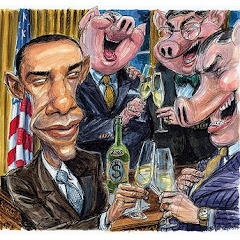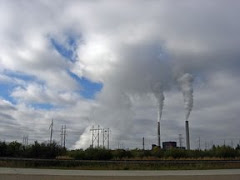Monday, April 15, 2013
Wary of China, Companies Head to Cambodia
The time has come to talk about the "ownership" question.
Should Wall Street investors be allowed to own the mines, mills and factories or is it time to talk about nationalization under public ownership of the mines, mills and factories?
Alan L. Maki
Link:
http://www.nytimes.com/2013/04/09/business/global/wary-of-events-in-china-foreign-investors-head-to-cambodia.html?pagewanted=all&_r=0


Should Wall Street investors be allowed to own the mines, mills and factories or is it time to talk about nationalization under public ownership of the mines, mills and factories?
Alan L. Maki
See response by Immanuel Wallerstein following the article.
Link:
http://www.nytimes.com/2013/04/09/business/global/wary-of-events-in-china-foreign-investors-head-to-cambodia.html?pagewanted=all&_r=0

Wary of China, Companies Head to Cambodia
By KEITH BRADSHER
Published: April 8, 2013
PHNOM PENH, Cambodia — Tiffany & Company is quietly building a diamond-polishing factory in Cambodia, a country popularly associated more with killing fields and land mines than baubles.
Multimedia

Some of Japan’s biggest manufacturers are also rushing to set up operations in Phnom Penh to make wiring harnesses for cars and touch screens and vibration motors for cellphones. European companies are not far behind, making dance shoes and microfiber sleeves for sunglasses.
Foreign companies are flocking to Cambodia for a simple reason. They want to limit their overwhelming reliance on factories in China.
Problems are multiplying fast for foreign investors in China. Blue-collar wages have surged, quadrupling in the last decade as a factory construction boom has coincided with waning numbers of young people interested in factory jobs. Starting last year, the labor force has actually begun shrinking because of the “one child” policy and an aging population.
“Every couple days, I’m getting calls from manufacturers who want to move their businesses here from China,” saidBradley Gordon, an American lawyer in Phnom Penh.
But multinational companies are finding that they can run from China’s rising wages but cannot truly hide. The populations, economies and even electricity output of most Southeast Asian countries are smaller than in many Chinese provinces, and sometimes smaller than a single Chinese city. As companies shift south, they quickly use up local labor supplies and push wages up sharply.
While wages and benefits often remain below levels needed to provide proper housing and balanced diets, the manufacturing investment — foreign direct investment in Cambodia rose 70 percent last year from 2011 — is starting to raise millions of people out of destitution. “People along the Mekong River are being lifted out of poverty by foreign investment inflows driven by higher Chinese wages,” said Peter Brimble, the senior economist for Cambodia at the Asian Development Bank.
Only a smattering of companies, mostly in low-tech sectors like garment and shoe manufacturing, are seeking to leave China entirely. Many more companies are building new factories in Southeast Asia to supplement operations in China. China’s fast-growing domestic market, large population and huge industrial base still make it attractive for many companies, while productivity in China is rising almost as fast as wages in many industries.
Foreign investment in China nonetheless slipped 3.5 percent last year, after rising every year since 1980 except 1999, during the Asian financial crisis, and 2009, during the global financial crisis. Still, at $119.7 billion, foreign investment in China continues to dwarf investment elsewhere.
By comparison, investment in Cambodia rose to $1.5 billion. But last year was the first time since comparable recordkeeping began in the 1970s that Cambodia received more foreign investment per person than China.
“People are not looking for exit strategies from China, they’re looking to set up parallel operations to hedge their bets,” said Bretton Sciaroni, another American lawyer here. Among Japanese makers, Sumitomo is making wiring harnesses for cars, Minebea is assembling parts for cellphones and Denso is about to start production of motorcycle ignition components.
Foreign investment also jumped last year in Vietnam, Thailand, Myanmar and the Philippines.
As companies compete for employees, working conditions in the region are improving. Pactics, a Belgian-run company that is the world’s largest maker of microfiber sleeves for luxury sunglasses, has introduced employee benefits that were previously rare in Cambodia, like medical insurance, accident insurance, education allowances and free lunches.
Because costs are extremely low in Cambodia, where a visit to the doctor may cost only a couple of dollars, overall compensation for each worker is still less than $130 a month. At the company’s factory on the outskirts of Shanghai, workers doing the same tasks earn $560 to $640 a month, including government-mandated allowances, said Piet Holten, the company’s president.
Cambodian workers sew 15 to 30 percent fewer sleeves per day than their Shanghai counterparts, but productivity in Cambodia has been catching up.
“I will never get it up to China, but the cost is less than a third of China’s, and China only gets more expensive,” Mr. Holten said.
Overall monthly compensation for industrial workers has increased as much as 65 percent in the last five years in Cambodia, although from such a low base that workers here remain among the poorest in Asia. A decade ago, workers flocked to newly opened factories in Phnom Penh that posted hiring notices, but “today, you put a notice on a factory and you don’t have anybody come,” said Sandra D’Amico, the managing director of HR Inc. Cambodia, a human resources company.
Strikes this winter temporarily crippled numerous Taiwanese-owned garment factories in eastern Cambodia producing simple garments like bathing suits after Japanese factories moved in to make more sophisticated products like business suits and gloves — and offered higher pay and benefits.
At the Phnom Penh Special Economic Zone here in central Cambodia, Minebea is trying to attract workers by building a modern, four-story dormitory for 2,000 people with six beds to a room and a large recreation hall — a big change from the plywood houses with thatched roofs in which millions of Cambodians still live. The Laurelton Diamonds unit of Tiffany has already driven pilings for a modern, 95,000-square-foot factory across the street to polish small diamonds, and is seeking international “green building” accreditation for the project.
Employment at the zone is doubling this year, to 20,000 workers, and is projected to redouble to 40,000 in the next several years, said Hiroshi Uematsu, the zone’s managing director.
Skeptics like David J. Welsh, the Cambodia representative of the A.F.L.-C.I.O.’s Solidarity Center, say that rising food and housing costs prevent many workers from fully benefiting from rising wages. Ken Loo, secretary general of the Garment Manufacturers Association in Cambodia, said that his industry needed to resist workers’ demands for further pay increases to preserve international competitiveness.
Tatiana Olchanetzky, a manufacturing consultant to companies in the handbag and luggage industry, said that she had analyzed the costs in her industry of moving operations from China to the Philippines, Cambodia, Vietnam and Indonesia. She found that any savings were very small because China produces most of the fabrics, clasps, wheels and other materials required for the bag trade, and these would have to be shipped to other countries if final assembly moved there.
But some factories have moved anyway, at the request of Western buyers who fear depending exclusively on a single country.
While moving to a new country with an unproved supply chain is a risk, Ms. Olchanetzky said, “They think there’s a risk in staying in China, too.”
A version of this article appeared in print on April 9, 2013, on page B1 of the New York edition with the headline: Hello, Cambodia.
Commentary No. 351, April 15, 2013
Ever since there has been a capitalist world-economy, one essential mechanism of its successful functioning has been the runaway factory. After a period of significant accumulation of capital by so-called leading industries (usually about twenty-five years), the level of profit has gone down, both because of the undermining of the quasi-monopoly of the leading industry and because of the rise in labor costs due to syndical action of some sort.
When this happened, the solution was for the factory to "runaway." What this means is that the site of production was transferred to some other part of the world-system that had "historically lower wage levels." In effect, the capitalists who controlled the leading industries were trading increased transaction costs for reduced labor costs. This maintained significant income for them, if nonetheless lower than in the previous period when they still had a quasi-monopoly.
The reason why labor costs were lower in the new location is that the runaway factory recruited labor from rural areas that were previously less involved in the market economy. For these rural workers, the opportunity to work in these runaway factories represented a rise in real income, while at the same time for the owners of the runaway factory these workers were being paid less than those who had been working in the previous location. This is what is called a win-win solution.
The problem with this seemingly wonderful solution has always been that it was not lasting. After about another twenty-five years, the workers in the new location began to launch syndical action, and the cost of their labor began to rise. When it rose enough, the owners of the runaway factory had only one real option - to runaway once again. Meanwhile, new leading industries were being constructed in zones that had accumulated wealth. Thus, there has been a constant movement of the location of industries of all sorts. Quasi-monopolies after quasi-monopolies! Runaway factories after runaway factories!
It has been a marvel of capitalist adjustment to a long process of constant change of circumstance. This marvelous system has however depended on one structural element - the possibility of finding new “virgin” areas for relocation of runaway factories. By virgin areas, I mean rural zones that were relatively uninvolved in the world market economy.
However, over the past 500 years, we have been "using up" such areas. This can be measured quite simply by the de-ruralization of the world's populations. Today, such rural areas are reduced to a minority of the world's surface, and it seems likely that by 2050, they will be a very, very small minority.
To see the consequences of such massive de-ruralization, we need only turn to an article in The New York Timesof April 9. It is entitled "Hello, Cambodia." The article describes the "flocking" to Cambodia of factories that are fleeing China because of the rise of wage-levels in China, a previous recipient of such runaway factories. However, the article continues, "multinational companies are finding that they can run from China's rising wages but cannot truly hide."
The problem for the multinationals is that the incredible expansion of communications has caused the end of the win-win situation. Workers in Cambodia today have begun syndical action after only a few years, not after twenty-five. There are strikes and pressure for higher wages and benefits, which they are receiving. This of course reduces the value for the multinationals of moving to Cambodia, or Myanmar, or Vietnam, or the Philippines. It now turns out that the savings of moving from China are not all that great.
The Times article notes that "some factories have moved anyway, at the request of Western buyers who fear depending on a single country." Conclusion of a manufacturing consultant: There are risks of moving to Cambodia, but "there's a risk in staying in China, too." In any case, is there somewhere to move the runaway factory? Or is Cambodia the end of the line?
The bottom line is that the combination of already enormous and still increasing de-ruralization and the rapidity with which workers can learn of their relatively low wages and therefore begin to take syndical action has resulted in a continuing rise in the pay levels of the least skilled workers, and therefore a worldwide negative pressure of the possibilities of accumulating capital. This is not good news for the large multinationals.
This is all one element in what has become the structural crisis of the modern world-system. We are experiencing a combination of ever-increasing austerity pressures on the 99% with a capitalist system that is no longer so profitable for capitalists. This combination means that capitalism as a world-system is on its way out.
Both sides are seeking alternatives - but obviously different ones. We are collectively facing a "choice" over the next decades. One possibility is a new non-capitalist system that replicates (and perhaps worsens) the three essential features of capitalism - hierarchy, exploitation, and polarization. The other possibility is a new system that is relatively democratic and relatively egalitarian. The latter system, one should underline, has never existed in the history of the world. But it is possible.
In any case, Cambodia is not the future of the modern world-system. It represents rather the last vestiges of a mechanism that no longer performs its task in salvaging capitalism.
by Immanuel Wallerstein
Subscribe to:
Comments (Atom)
















































































































